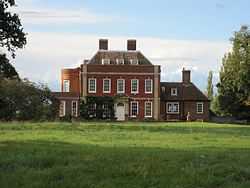Tetworth
| Tetworth | |
 Tetworth Hall |
|
 Tetworth | |
| Population | 45 (2001) |
|---|---|
| OS grid reference | TL217528 |
| Civil parish | Waresley cum Tetworth |
| District | Huntingdonshire |
| Shire county | Cambridgeshire |
| Region | East |
| Country | England |
| Sovereign state | United Kingdom |
| Postcode district | SG19 |
| Police | Cambridgeshire |
| Fire | Cambridgeshire |
| Ambulance | East of England |
| EU Parliament | East of England |
| |
Tetworth – in Huntingdonshire (now part of Cambridgeshire), England – is a small village near Waresley south of St Neots.
Tetworth is in the ward of Gransden and the Offords in the District of Huntingdonshire.
History

Originally a hamlet in the parish of Everton, Bedfordshire, Tetworth has a complicated administrative history. The hamlet, which was considered a civil parish separate from Everton from the Inclosure Award of 1802, was in two distinct parts. The northern part was in Huntingdonshire, the southern partly an exclave of Huntingdonshire and partly of Bedfordshire. The Counties (Detached Parts) Act 1844 assigned the Bedfordshire part to Huntingdonshire, so that the entire southern section became an outlier of Huntingdonshire, separated from the rest of the county by a salient of Cambridgeshire. This situation remained until 1965, when two new counties of Cambridgeshire and Isle of Ely and Huntingdon and Peterborough were formed. At this time both county and parish boundaries were adjusted, Tetworth now being a single area in Huntingdon and Peterborough. In 1974 it was made part of the enlarged Cambridgeshire. The parish, formerly covering 2,235 acres (904 ha) was combined with Waresley on 1 April 2010, as Waresley cum Tetworth.[1][2]
Listed as Tethewurda in the 12th century and Tetteworth or Tettesworthe in the 13th century, the name Tetworth is believed to mean "farmstead of a man named Tetta".[3]
A Roman road from Sandy to Godmanchester runs through Tetworth, with a footpath following most of its route.
Church
For ecclesiastical purposes both Everton and Tetworth were always part of the single Everton (or Everton-cum-Tetworth) parish, with the parish church situated in the detached part of the Tetworth civil parish. The church, dedicated to St Mary, was mentioned in the Domesday Book but was rebuilt in the 12th century, with the majority of that building still surviving today. A west tower was added in the 14th century, and the chancel was rebuilt in the 15th century.[2]
John Berridge, friend of John Wesley, was vicar of the parish between 1755 and 1793.[2]
Tetworth Hall
Tetworth Hall stands on the edge of the Greensand Ridge overlooking the valley of the River Ivel at the southern end of the present parish. The house was built in 1710 for the MP John Pedley, and is a two-storey red brick mansion in the Queen Anne style to which it dates.[4]
After the Pedley line died out in 1726, the house was bought by Edward Harley, 2nd Earl of Oxford before passing to the Lord Chancellor, Philip Yorke, 1st Earl of Hardwicke in 1740. In 1759 it was acquired by Stanhope Pedley, a relation of the original owners, who retained it until 1823 after which it passed to the Foley family.[4]
By 1895 it was owned by Charles Duncombe, 2nd Earl of Feversham who leased it to Augustus Scobell Orlebar. His son, Augustus Orlebar, was a distinguished RAF pilot.
During the Second World War it was requisitioned by the government, though its use during this period is not fully known.[4]
References
- ↑ The Huntingdonshire (Parishes) Order 2009 Retrieved 25 September 2010
- ↑ 2.0 2.1 2.2 A History of the County of Huntingdon 2. 1932. pp. 370–374.
- ↑ W. W. Skeat (1903). Place names of Huntingdonshire and Bedfordshire.
- ↑ 4.0 4.1 4.2 Bernard O'Connor (2000). "Tetworth Hall".